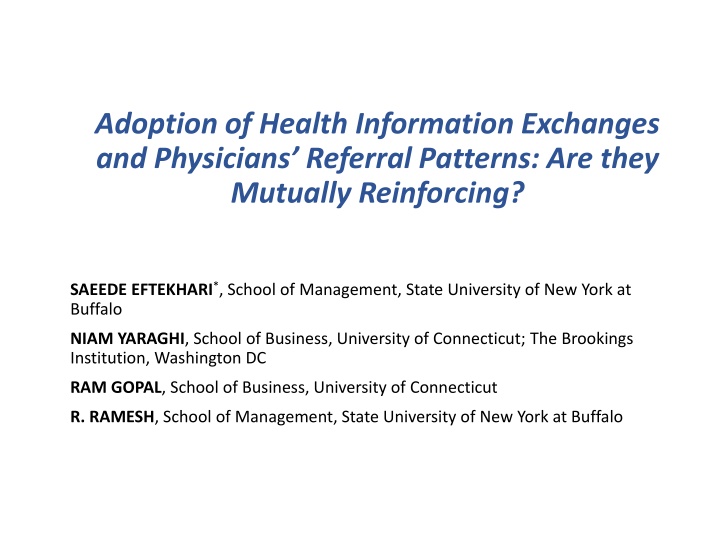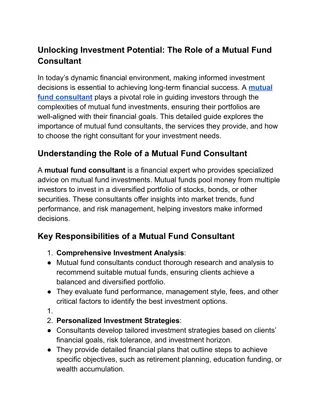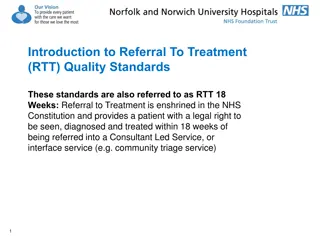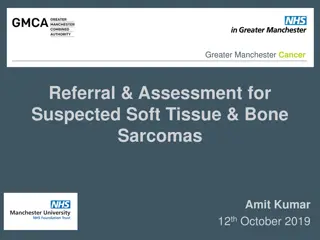Adoption of Health Information Exchanges and Physician Referral Patterns: Mutual Reinforcement?
This study investigates the impact of Health Information Exchange (HIE) membership on primary care physicians' referral networks. It explores the relationship between HIE adoption and physicians' choice of specialists, analyzing factors such as communication, care quality, and administrative efficiency. The research examines the dynamics of referrals within HIE member and non-member networks, highlighting the influence of social interaction and perceived value. Hypotheses are proposed to understand how HIE adoption influences physician referrals and interactions between HIE members and non-members.
Download Presentation

Please find below an Image/Link to download the presentation.
The content on the website is provided AS IS for your information and personal use only. It may not be sold, licensed, or shared on other websites without obtaining consent from the author.If you encounter any issues during the download, it is possible that the publisher has removed the file from their server.
You are allowed to download the files provided on this website for personal or commercial use, subject to the condition that they are used lawfully. All files are the property of their respective owners.
The content on the website is provided AS IS for your information and personal use only. It may not be sold, licensed, or shared on other websites without obtaining consent from the author.
E N D
Presentation Transcript
Adoption of Health Information Exchanges and Physicians Referral Patterns: Are they Mutually Reinforcing? SAEEDE EFTEKHARI*, School of Management, State University of New York at Buffalo NIAM YARAGHI, School of Business, University of Connecticut; The Brookings Institution, Washington DC RAM GOPAL, School of Business, University of Connecticut R. RAMESH, School of Management, State University of New York at Buffalo
Health Information Exchange (HIE) Physician Visits Records Lab Test Results Hospital Records Insurance Information Prescription Information Patients Electronic Data Physician Accessibility of Patient Data
Referral In a referral process, usually there is a set of possible choices of specialists to refer to. The refereeing physicians consider the following factors: Availability of doctors Physicians satisfaction with prior referrals Physicians communication
Our basic question: Is HIE membership impacting the referral network with regards to the primary care physicians choice of specialist? HIE member ? HIE member Non-member
Why HIE members tend to refer to HIE members? (i) HIE facilitate the communication between doctors in a referral process. (ii) The referred physician will be able to provide a better care to the patient. (iii) HIE reduces the amount of administrative work.
Reverse relationship exists too member Non-member member Non-member
Reverse relationship also exist member Non-member member Non-member Why? 1. Social influence Becomes member 2. Increased perceived value of HIE as a result of more interaction with HIE members.
Hypotheses H1: HIE adoption Referring to HIE members H2: The interaction between a HIE non-member and a member HIE adoption
How to test? Secondary data (i) HIE adoption in the Western New York (Healthelink) (ii) Panel referral network data 2009-2014 (CMS) Social Network Analysis SIENA: Simulation Investigation for Empirical Network Analysis
The referral network is dynamic S1 P1 S2 S3 T1 T2
The referral network is dynamic S1 P1 S2 S3 T1 T2 Creating a new tie S1 P1 S2 S3
The referral network is dynamic S1 P1 S2 S3 T1 T2 Terminating an existing tie S1 P1 S2 S3
The referral network is dynamic S1 P1 S2 S3 T1 T2 Remaining in the same state S1 P1 S2 S3
Basic assumption of actor-oriented model Creating? Terminating? Remaining in the same state? ???????= ??( ??????????? ???) + ??(??????????)+e ???????????? ?
How does SIENA estimate parameters? S1 S1 P1 S2 P1 S2 S3 S3 T2 T1 S1 P1 S2 S3 The transition process starts with a set on initial parameters { }
How SIENA estimate parameters: S1 S1 P1 S2 P1 S2 S3 S3 T2 T1 S1 S1 S1 P1 S2 P1 P1 S2 S2 S3 S3 S3 The simulated network at T2 is compared with real observed network and parameters get updated
Co-evolution: 0 S1 0 1 S1 0 1 P1 S2 1 P1 S2 1 S3 1 S3 T2 T1 0 S1 S1 S1 1 1 P1 P1 S2 P1 S2 S2 1 S3 S3 S3
Results of modeling referral network (2013-2014) 3.929*** (0.136) Rate parameter for referral network -3.389*** (0.057) Density 0.028*** (0.001) 4-cycle 0.025*** (0.004) Popularity 0.109* (0.061) Dyadic covariate effect for gender 1.082*** (0.101) Dyadic covariate effect for practice -0.005** (0.003) Popularity effect for experience 0.040 (0.093) Activity effect for HIE -0.309*** (0.099) Popularity effect for HIE 1.506***(0.199) Homophily effect for HIE
Results of modeling HIE adoption for primary care physicians (2013-2014) Rate parameter for adoption by primary care physicians 1.087*** (0.284) -0.068 (0.066) Out-degree 3.667*** (1.149) Covariate Effect of EHR 0.827 (0.738) Covariate Effect of Gender -0.114** (0.046) Covariate Effect of Exp 1.867*** (0.525) Ties with HIE member physicians
Results of modeling HIE adoption for specialists (2013-2014) Rate parameter for adoption by primary care physicians 0.424*** (0.097) -0.039 (0.071) In-degree 2.449** (0.994) Covariate Effect of EHR 1.548 (1.066) Covariate Effect of Gender 0.066* (0.039) Covariate Effect of Exp 1.204*** (0.296) Ties with HIE member physicians
This study Uncovers homophily relationships of HIE member physicians in the referral network; Supports the social influence on HIE diffusion; Provides important insights on the benefits of HIE to the overall healthcare system; Explores dominant factors shaping the referral network.























